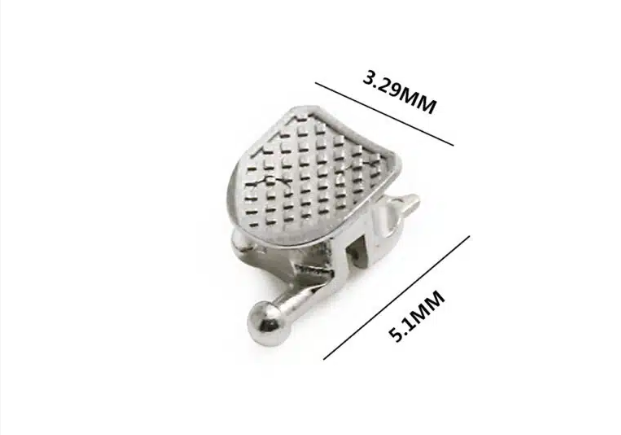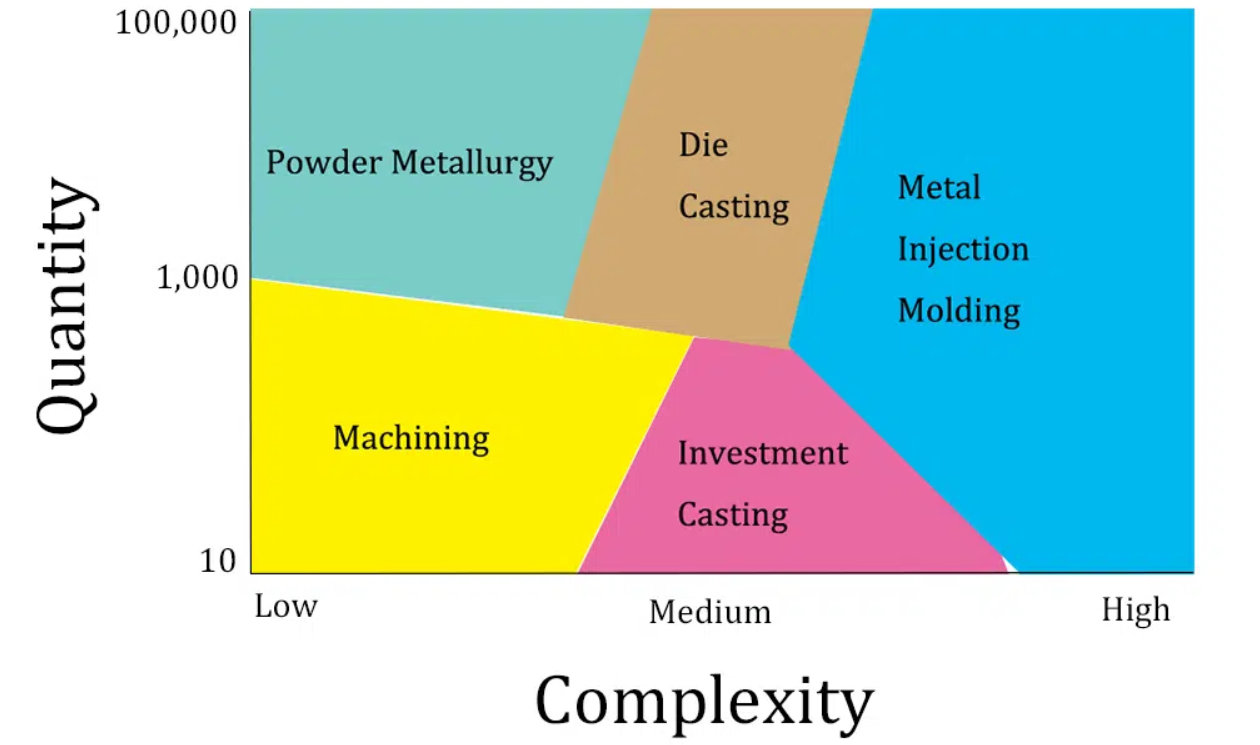Metal injection molding (MIM) and powder metallurgy (PM) are both powder based metal processing technologies for metal parts. At the same time, both MIM and PM technologies are applicable to high-quality small metal products. Manufacturers around the world are purchasing to produce high-quality metal parts with complex geometries. They like to design components freely without sacrificing cost. The traditional casting method can no longer meet these special requirements. Therefore, new molding processes such as metal injection molding (MIM) and powder metallurgy (PM) are more and more suitable for metal parts with high tolerance, excellent surface and specific properties.
Metal injection molding (MIM) is a metal processing process, which combines powdered metal particles with adhesive materials to form a mesh of metal parts and components. In addition, unlike other technologies, MIM can produce small and complex parts at a lower cost. It is the only technology available for thin wall sizes with a thickness of 0.1 mm. In addition, its unique injection molding process can integrate multiple parts into a single part.
First, the metal powder is mixed with a polymer binder for MIM raw materials.
Secondly, the raw materials are injected into the molding machine for the specific shape of the parts - green.
Third, remove the adhesive - degreased blank through chemical or thermal degreasing process.
Finally, sintered brown parts are used for metal powder densification and metallurgical bonding.
First, mix or mix specific metal powders and lubricants.
Secondly, a small press is used to form a certain shape in the mold.
Finally, the compressed parts are sintered into the final parts combined with powder metallurgy in the furnace.
Although MIM and PM use the same base metal powder and custom metal alloy, the key difference between MIM and powder metallurgy materials is particle size. MIM powder (2-15 μm) is smaller than PM powder (50-100 μm), which leads to lower porosity of parts in MIM process. Therefore, after sintering, the density of MIM parts will reach more than 95%, while the maximum density of PM parts can only reach 92%.
In addition, the cost of powder metals is another key factor in comparing metal injection molding (MIM) and powder metallurgy (PM) materials. Powder metallurgy (PM) powders are cheaper. However, metal injection molding (MIM) is more expensive because its finer powder size requires more process and energy to produce. Therefore, the more expensive material is the finer MIM material, and the porosity of the final MIM parts produced by metal injection molding is significantly reduced.

Powder metallurgy uses high pressure uniaxial compression to form sharp parts in real time, so it is more suitable for parts with simple shape and easy to pop out of the mold cavity. In MIM technology, there are very few geometric restrictions on 3D design degrees of freedom. Therefore, MIM can combine 2 or more sub components into a single part. The following are normal MIM design improvements:
Component merging: MIM will merge individual sub components into one MIM component.
Uniform wall thickness: MIM can even the wall thickness of all parts to produce products with high tolerance.
Coring and weight reduction: MIM uses coring to reduce material waste and will not affect the application of parts in further use.
Hole and groove, undercut and thread: all these items are used for further assembly with other parts.
Knurling, letters and logos: MIM uses these items to improve the surface appearance of metal parts.
In order to become familiar with the main differences between Metal Injection Molding (MIM) and Powder Metallurgy (PM), we have summarized the common different features, as shown in the following table.
Parameters | Metal Injection Molding(MIM) | Powder Metallury(PM) |
Density | 94-98% | <93%(Max) |
Powder Paeticle size | 2-15 micron (μm) | 50-100 micron (μm) |
Cost | Medium | Low |
Miniaturization | High | Medium |
Geometric Complexity | High | Medium |
Design Flexibility | High | Medium |
Thin Wall Capability | High(0.30-10 mm) | Medium(2-20 mm) |
Material Ranges | High | High |
Production Quantity | High | High |
Post-operation Feasibility | Good | Poor |
Dimensional Tolerance | High(0.2-0.5%) | High(0.1-2.0%) |
Weight | 0.1-200 gram | 1-1,000 gram |
As powder metallurgy forms part shape on a unique shaft, friction and tension between metal powder and die surface will lead to non-uniformity of the final part. In contrast, MIM parts can rub and tension evenly in all directions. Finally, MIM parts will show higher physical properties than PM parts, such as surface appearance and corrosion resistance. In addition, for the same material, the sintering temperature of MIM (1280 ℃ - 1370 ℃) is much higher than that of PM (980 ℃ - 1100 ℃). Compared with powder metallurgy parts, the combination of fine metal powder makes MIM parts have better physical properties, such as toughness and fatigue strength.
We summarized the main physical properties of metal injection molding and powder metallurgy:
| Metal Injection Molding(MIM) | Powder metallurgy (PM) |
Elongation | High | Low |
Hardness | High | Low |
Surface finish | High | Medium |
Tensile strength | High | Low |
MIM is very suitable for complex design parts. Liquid raw materials and injection molding can form any structure with a corresponding mold cavity. Unlike powder metallurgy processes, metal powders can only be diecasted to the desired shape. MIM can create complex geometric shapes through various cavity structures. In addition, it is cost-effective to combine several separated components into one MIM component.
On the contrary, PM technology can only produce these parts separately, and then manually assemble them into the final product. In this case, we can easily realize that MIM is more cost-effective than PM for parts with complex geometry.

In the MIM and PM processes, the sintering temperatures are different from each other for the same alloy material. Therefore, the MIM sintering process will add significant cost to the manufacturing process compared to powder metallurgy. On the other hand, we need to consider the following other unpaid returns.
MIM technology utilizes smaller sized powders and higher temperature sintering. It will remove adhesives and other impurities. To achieve the actual size, there are higher design tolerances than PM.
Higher sintering temperature promotes more metal powder to melt, so as to eliminate surface pores in the process. Therefore, the density of MIM parts is higher than that of PM parts.
The surface toughness of MIM parts can reach 1 μm, which is very suitable for further secondary processing without additional processing. In contrast, permanent magnetic materials need to be polished before further surface treatment.
The high density and delicate surface of MIM parts ensure higher corrosion resistance than PM.
The high-temperature sintering process will undoubtedly improve the physical properties of the metal, such as fatigue strength.Therefore, the performance of MIM parts will be better than that of PM parts of the same material.
In order to choose the most cost-effective method of manufacturing metal parts, we need to analyze the number and complexity of parts for your project. For simple parts, PM may be cost-effective. However, MIM can produce metal parts with complex geometries and greatly save costs in secondary operations. Especially for two or more substantial parts, they need to be assembled in further operations. MIM technology can use only one MIM part to produce these types of parts. This will save the total cost of materials, design, assembly and logistics. In addition, MIM will reduce the failure rate in the manufacturing process.
As shown in the figure below, we should consider the complexity and volume of the parts to choose the most economical manufacturing method.PM can only meet the requirements of simple structural metal parts, and MIM can solve the choice of complex geometries.

Metal parts manufacturing is a complex process that is affected by various factors.Once you plan your next project, you need to consider all the projects.Below, we provide the key factors you should pay attention to:
Size and weight restrictions: The size and weight of your metal parts will determine the main manufacturing method.Both PM and MIM are suitable for small metal parts with a size and weight range of 1-200 grams.
Tolerance limit: MIM is most suitable for metal parts with high tolerances.If you need high-precision metal parts, MIM is the only best choice.
Secondary operation: MIM components facilitate further secondary operation.Once you plan to add further surface treatments, such as coating, painting or anodizing, MIM is the perfect manufacturing method.
Performance requirements: MIM parts have almost 100% of the physical properties of raw materials.If your metal parts require special metal physical properties, such as electrical and thermal conductivity, and high fatigue strength, MIM technology will easily meet all your requirements.
New features: MIM is more suitable for specific projects that have not completed functions or areas in the past.For example, we can produce new design details through new functional optimization, but we only need to make simple adjustments in MIM manufacturing.MIM technology provides more production possibilities than PM.
Contact: Cindy Wang
Phone: +86 19916725892
Tel: 0512-55128901
Email: [email protected]
Add: No.6 Huxiang Road, Kunshan development Zone, JiangsuShanghai Branch: No. 398 Guiyang Rd, Yangpu District, Shanghai, China